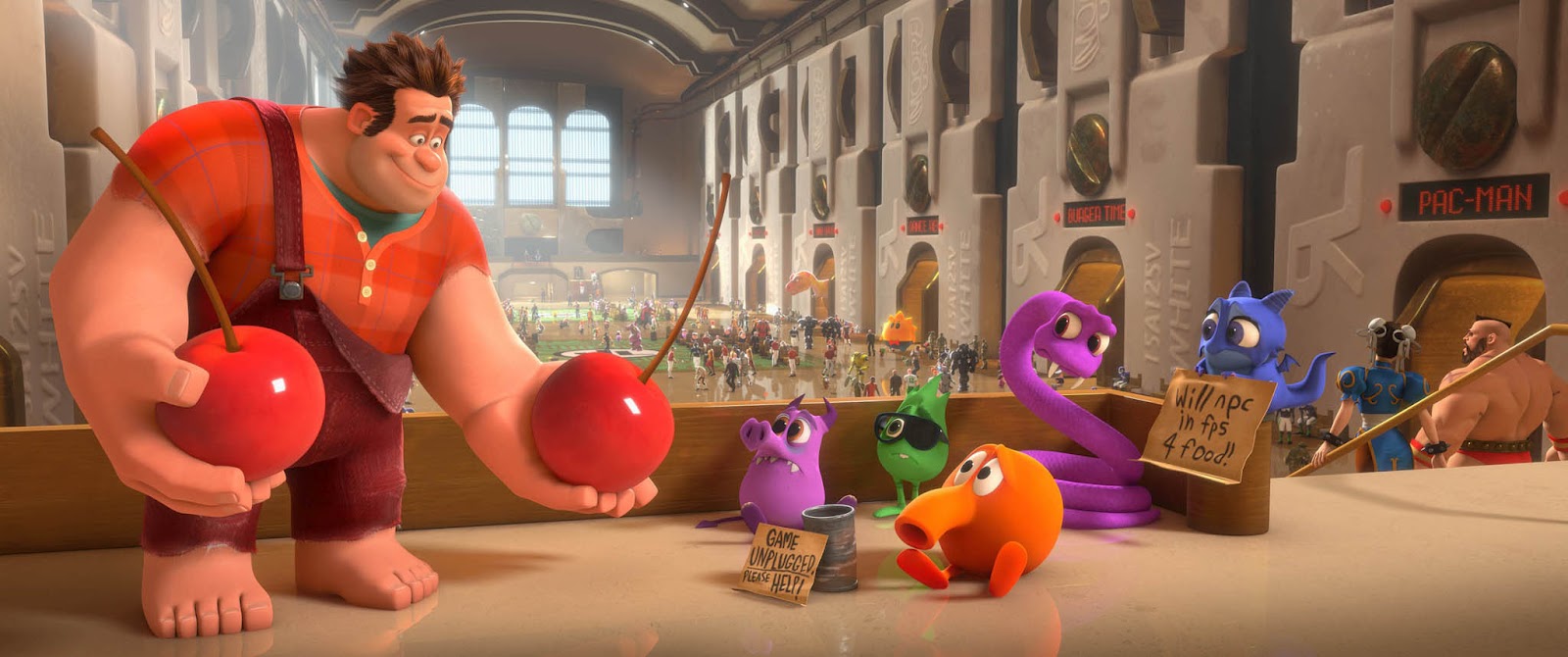Wreck-It Ralph’s highly orchestrated diegesis is an arcade universe awash in references to video-game culture, an 8-bit fantasyland in which characters come to life (a la Toy Story) to mingle outside their respective games once the arcade closes. Wreck-It Ralph’s (John C. Reilly) day job is being the lumberous bad guy in a platformer game (reminiscent of Donkey Kong) called Fix-It Felix Jr. As his name denotes, Ralph’s job is to smash up an apartment building. As window and door pixels go a-flutter, the trusty Felix (Jack McBrayer) comes to the rescue with the help of the player and Felix’s magic golden hammer. The apartment inhabitants are a snooty crew known as the Nicelanders who kvell over Felix’s do-good work and treat Ralph as if he were actually a bad guy. In typical Disney fashion, Ralph wants to change his predetermined fate to be rewarded for something good, like Felix gets to do every day, so that he can gain the respect of the Nicelanders and be invited to their parties. Ralph sees his chance by sneaking into a Halo-like first-person shooter game called Hero’s Duty to obtain the game’s medal but his unwieldiness lands him in Sugar Rush, a Mario Kart imitation, his stolen medal lost in the game’s programming matrix. There, he befriends Vanellope von Schweetz (Sarah Silverman), a game glitch who, like Ralph, wants to feel validated as a character and race in her own game. The two team up to make their dreams come true in the predictably prefabricated soul-searching, friend-bonding, villain-defying Disney formula we all know backwards, forwards and could all write with our eyes closed and hands tied behind our backs.
The narrative, while serviceable, isn’t the biggest or most interesting problem in the film. There is definitely a cleverness to the diegetic world of Wreck-It Ralph that is highly appealing to Gen X- and Gen Y-ers who played games back when arcades were still a thing and 8-bit wasn’t yet a highly fetishized nostalgia aesthetic. But more frequently than not, the references and the parameters in which video-game logic is employed in Wreck-It Ralph devolve into simplistic gags to make the viewer feel smart for getting the reference, and they sometimes corrupt the film’s internal logic (it doesn’t make a lick of sense to include a contemporary game like Hero’s Duty in an arcade, but it is greatly convenient for the storyline, so in it goes). Referential jokes are not themselves the problem, it’s that their employment is frequently nothing more than non-sequiturs, as if Wreck-It Ralph was inspired by a YouTube playlist of memes.
When Ralph fishes through the lost-and-found box at Root Beer Tapper (yep, that one), he finds the exclamation mark from Metal Gear Solid as well as a thong belonging to Street Fighter’s Zangief. Neither joke is particularly funny, but at least Zangief was already established in a previous scene as a real character within the film, one with a tendency to overshare details about his personal life. Ralph’s bemused expression upon finding the Street Fighter villain’s sweaty undergarment builds on something the film has established itself all the while exploiting a well-known gaming reference that will register waves of nostalgia in savvy viewers who will delight in the reappropriation. Zangief is an example of what the film does well when employing video-game icons, because it actually does something with a reference instead of making it into a glib one-liner intended to garner a chuckle from the adult audience. What is most disheartening about the film relying so heavily on the Seth MacFarlane model of comedy is that the film’s director is storyboard/writing vet Rich Moore from “The Simpsons,” a show so influential its comedic DNA can be found in just about any show post-1995, including everything MacFarlane has touched.
Wreck-It Ralph is apparently a PG-rated film, in case you forgot it was intended for children like I did. So much of the humor goes bouncing over their heads like Angry Birds (a game that many kids would have recognized if included in this film, but hey, it doesn’t carry the same nostalgia currency as Mario). The children at my screening did not laugh or cry out in delight even once during Wreck-It Ralph, but the twentysomethings were uproarious. The only aspect in Wreck-It Ralph the kids have going for them is the Disney story, which works for now, but in about 15 years scores of twentysomethings will be writing Criminally Overrated pieces on the film.

